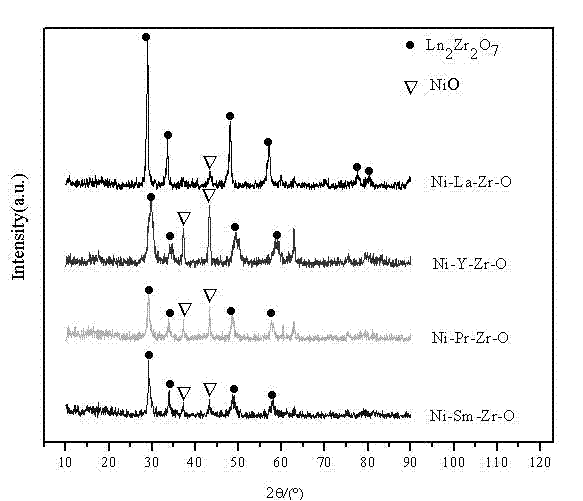Anti-carbon-deposition Ni-based catalyst for hydrogen production by methane steam reforming and preparation method thereof
A methane water vapor, reforming hydrogen production technology, applied in the field of catalysis, can solve the problems of unsatisfactory catalytic activity and stability, and achieve the effects of strong anti-carbon deposition, easy control of conditions, and low cost
- Summary
- Abstract
- Description
- Claims
- Application Information
AI Technical Summary
Problems solved by technology
Method used
Image
Examples
Embodiment 1
[0031] Ni / La 2 Zr 2 o 7 Particle catalyst, the preparation method is as follows:
[0032] (1) La(NO 3 ) 3 ·6H 2 O, Zr(NO 3 ) 3 ·3H 2 O is dissolved in metered deionized water to form a solution with a concentration of 0.5mol / L;
[0033] (2) Dilute the industrial ammonia water with a concentration of 25% to 1 times as a precipitating agent. Under continuous stirring, add the salt solution obtained in (1) dropwise to the above precipitating agent, control the pH=10, and after the precipitation is complete, let it stand at room temperature. After 12 hours, wash with deionized water until the TDS of the filtrate2 Zr 2 o 7 Composite oxide support, characterized by XRD, such as figure 1 As shown, the support has pyrochlore-type structure characteristic diffraction peaks; X-ray diffraction results show that catalysts with pyrochlore-type structures containing different rare earths have been synthesized.
[0034] (3) Ni(NO) with a nickel content of 12% catalyst mass 3 ) ...
Embodiment 2
[0037] Ni / Y 2 Zr 2 o 7 Particle catalyst, the preparation method is as follows:
[0038] (1) Y(NO) with Y:Zr (molar ratio) of 1:1 3 ) 3 ·6H 2 O, Zr(NO 3 ) 3 ·3H 2 O is dissolved in metered deionized water to form a solution with a concentration of 0.5mol / L;
[0039] (2) Dilute the industrial ammonia water with a concentration of 25% to 1 times as a precipitating agent. Under continuous stirring, add the salt solution obtained in (1) dropwise to the above precipitating agent, control the pH=10, and after the precipitation is complete, let it stand at room temperature. After 12 hours, wash with deionized water until the TDS of the filtrate2 Zr 2 o 7 Composite oxide support, characterized by XRD, such as figure 1 As shown, the carrier has pyrochlore-type structure characteristic diffraction peaks;
[0040] (3) Ni(NO) with a nickel content of 12% catalyst mass 3 ) 3 ·6H 2 O was dissolved in metered deionized water, and the prepared carrier was impregnated in metered...
Embodiment 3
[0043] Ni / Pr 2 Zr 2 o 7 Particle catalyst, the preparation method is as follows:
[0044] (1) Pr(NO 3 ) 3 ·6H 2 O, Zr(NO 3 ) 3 ·3H 2 O is dissolved in metered deionized water to form a solution with a concentration of 0.5mol / L;
[0045] (2) Dilute the industrial ammonia water with a concentration of 25% to 1 times as a precipitating agent. Under continuous stirring, add the salt solution obtained in (1) dropwise to the above precipitating agent, control the pH=10, and after the precipitation is complete, let it stand at room temperature. After 12 hours, wash with deionized water until the TDS of the filtrate2 Zr 2 o 7 Composite oxide support, characterized by XRD, such as figure 1 As shown, the carrier has pyrochlore-type structure characteristic diffraction peaks;
[0046] (3) Ni(NO) with a nickel content of 12% catalyst mass 3 ) 3 ·6H 2 O was dissolved in metered deionized water, and the prepared carrier was impregnated in metered nickel salt solution by equal...
PUM
| Property | Measurement | Unit |
|---|---|---|
| diameter | aaaaa | aaaaa |
Abstract
Description
Claims
Application Information
 Login to View More
Login to View More - R&D
- Intellectual Property
- Life Sciences
- Materials
- Tech Scout
- Unparalleled Data Quality
- Higher Quality Content
- 60% Fewer Hallucinations
Browse by: Latest US Patents, China's latest patents, Technical Efficacy Thesaurus, Application Domain, Technology Topic, Popular Technical Reports.
© 2025 PatSnap. All rights reserved.Legal|Privacy policy|Modern Slavery Act Transparency Statement|Sitemap|About US| Contact US: help@patsnap.com


